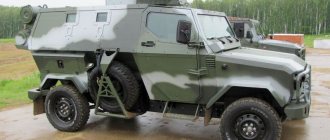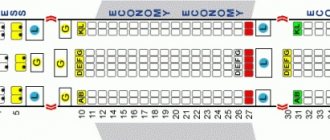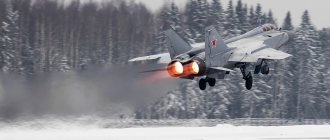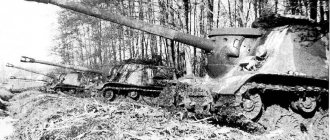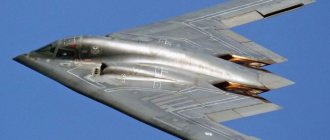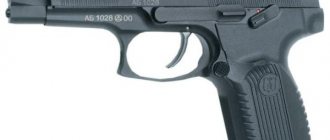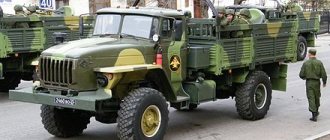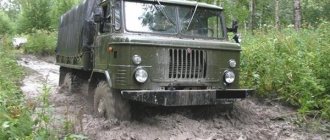ZIL-157 is an all-terrain truck, developed by the Likhachev Design Bureau as a chassis for combat installations, delivery of military cargo and military personnel to places of combat training missions.
See also the article Military KamAZ-55111 and its technical characteristics
ZIL-157 - platform for SZO
History[ | ]
From 1958 to 1961 the ZIL-157 was produced, from 1961 to 1978 - the ZIL-157K (in this model the load distribution along the axles was changed, a new gearbox, single-disc clutch, telescopic shock absorbers were used), in 1978 production was transferred to UAMZ ( Ural Automotive Plant), at that time one of the branches (PO AvtoZIL) under the symbol ZIL-157KD. It was produced there until 1991. It was widely used on collective farms and timber industry enterprises due to its high cross-country ability, unpretentiousness and body volume. The ZIL-157 received special love for its simplicity and reliability in the Soviet Army, for which it was essentially created. This basically explains its long serial production, and for a quarter of a century simultaneously with its descendant ZIL-131.
New engine
The 1978 base model “157KD” was equipped with an engine unified with the engine of the ZIL 130 car. The compression ratio was increased from 6.2 to 6.5. The piston group - cylinder liners, pistons, a set of compression rings, connecting rod pins - was completely borrowed from the 130 engine. The lubrication system was radically changed; the oil was now purified in a centrifugal filter.
The power of the water pump was significantly increased, a fundamentally new alternating current generator was installed, a small-sized, efficient unit. The standard starter was replaced with a high-speed, increased power one. The conventional distributor gave way to a contact-transistor ignition system. The updated engine was installed on the ZIL 157KD in the Ural branch of ZIL.
Features of operation[ | ]
The ZIL-157, like its predecessor ZIS-151, had a complex transmission with five driveshafts: intermediate (between the transfer case and gearbox); to the front axle; to the middle bridge; two driveshafts with an intermediate bearing unit on the middle axle approached the rear axle. The ZIL-157 used wheels and tires of size 12.00-18. For the first time in the Soviet automotive industry, a system of centralized tire pressure control was used on a truck. The driver could adjust the tire pressure from his seat (in all or by choice).
The car compressor made it possible to continue driving even with small holes in the tires. When moving through virgin snow or wetlands, it was possible to briefly reduce the pressure to 0.7 kg/cm2. At the same time, the vehicle speed should not exceed 10 km/h. The service life of the tires during such driving did not exceed 150 km (when operating with a normal pressure of 2.8 kg/cm2, the warranty mileage of the tires is 10 thousand km).
In winter, the machine requires careful supervision of the cooling system; if necessary, insulating casings are used on the radiator.
A serious drawback for such a heavy truck is the lack of hydraulic power steering.
History of the creation of ZIL-157
The creation of the first production model of an all-wheel drive truck with a 6X6 wheel arrangement was preceded by a period of improvement of the first versions of domestic trucks, which went through the following stages:
| date | Event |
| 1938 | The GAZ-31 all-terrain vehicle was developed, where the drive was carried out by a combined arrangement of rear axles with rubber tracks. A limited batch of ZIS-32 with two drive axles was produced at the Stalin Moscow Automobile Plant |
| 1939 | The first tests of the prototype GAZ-33 and GAZ-63 were carried out. At ZIS, research is being carried out to create a car with a 6X6 wheel arrangement (Studebaker) based on the ZIS-150. During World War II, the ZIS-150 was the main cargo transport, including being used to deliver the Katyusha self-propelled defense system. |
| 1946 | The first prototype of the three-axle ZIL-157 was created. But it was decided to use the ZIS-151 based on Studebaker as the basis for a production car - an SUV. As it turned out later, this was a mistake |
| 1948 | ZIS-151 began to be supplied to the SA and the national economy. Operation has shown that the technical characteristics and maneuverability in difficult conditions have decreased somewhat and become lower even in comparison with the ZIS-150. Exploration work continued |
| 1948-1968 | Modified models of the all-wheel drive GAZ-63 were mass-produced and widely used in the national economy and military purposes. |
| 1950-1962 | The production of an armored vehicle with increased cross-country ability ZIS-152 (BTR-152) based on the ZIS-151 was carried out |
| 1958 | The new ZIL-157 car and its technical characteristics are presented at an exhibition in Brussels |
| 1964 | ZIL-157K launched into serial production |
| 1978 | The modified ZIL-157KD began to be produced at the Ural Automotive Plant |
| 1994 | Serial production of the ZIL-157 and its modifications has officially ceased |
See also the article Onboard URAL-4320 its technical characteristics
The history of the creation of the ZIL-157 lasted almost 60 years. And to this day the car is used in many countries of the post-Soviet space. Domestic agricultural producers also did not give up the possibility of using a truck with unique cross-country ability - ZIL-157 - to solve problems in difficult field conditions.
60 years
This is how long the history of the creation of the ZIL-157 lasted
A good example is the ZIL-157 timber carrier. The machine is still in use at logging sites in Siberia and the Far East.
ZIL-157 timber carrier (photo)
ZIL-157 dump truck (photo)
Specifications[ | ]
- Curb weight, kg 5,540[3]
- front axle load, kg 2,400
- load on the rear trolley, kg 3 140
- Gross vehicle weight, kg 10,190
- front axle load, kg 2,770
- load on rear bogie, kg 7,420
- Ground clearance, mm 310[1]
- Height, mm 2,360 (with awning 2,915)
- Length, mm 6,684
- Base, mm 4 225
- Width, mm 2 315
- Maximum power, kW (hp) 80.2 (109)
- Maximum crankshaft rotation speed, rpm 2,800
- Maximum speed, km/h 60
- Gearbox ratios: 1st gear 7.44
- 2nd gear 4.10
- 3rd gear 2.29
- 4th gear 1.47
- 5th gear 1.00
- Reverse 7.09
- 1st gear 2.27
For ZIL-157 produced from 1958 to 1961:
- a) Rated power 76.5 kW (104 hp).
- b) Maximum speed 65 km/h.
- c) The gearbox ratios were different, as on the ZIS-150 and ZIS-151: 1st gear 6.24; 2nd gear 3.32; 3rd gear 1.898; 4th gear 1.00; 5th gear 0.81; Z.H. 6.70.
- d) The transfer case gear ratios were different, as on the ZIS-151: 1st gear 2.44; 2nd gear 1.24.
Bridges
The ZIL 157 car, regardless of modification, is equipped with three running units of the same type. These are planetary, semi-axle axles, with differentials. The gear ratios are identical for all three beams. The mounting brackets are designed for elliptic springs, although the suspension can be pendulum with springs and hydraulic shock absorbers.
The rather harsh operating conditions of the ZIL 157, whose axles experience the main load, forced designers to look for solutions that would increase the reliability of the vehicle’s suspensions. A fairly simple and reliable scheme was developed, which included the installation of hydraulic shock absorbers.
All axle shafts of the car are connected to cast iron drums, which are part of the fairly effective 157 braking system. The pads made from the universal feredo material worked flawlessly. The car almost never left tread marks on the road, the stop was smooth and without jerks that usually accompany the braking of heavy vehicles.
Modifications[ | ]
- ZIL-157 - basic model
- ZIL-157K - basic model since 1961, ZIL-130 parts were used in the design[4]
- ZIL-157V - truck tractor
- ZIL-157KV - truck tractor since 1961
- ZIL-157YU - tropical version
- ZIL-157G - with shielded equipment
- ZIL-157KG - with shielded equipment since 1961
- ZIL-157E - export version
- ZIL-157E - special chassis with two gas tanks (150 l each)
- ZIL-157KD - basic model since 1978. Equipped with a K-88AZh carburetor, some parts are unified with the ZIL-130[5]
- ZIL-157KDV - truck tractor since 1978
- ZIL-157 with KUNG-1M body - army van
- "Progress" - cabover bus on the ZIL-157 chassis
- PMZ-27 and PMZ-56A - fire engines based on ZIL-157
- KMM
is a track mechanized bridge on the ZIL-157 chassis, developed in 1959 in Kaliningrad to replace the bridge mod. 1957 on the ZIS-151 chassis and after completion of tests adopted by the armed forces of the USSR[6] - ZIL-4311
- a prototype developed to replace the ZIL-157
From the army to the national economy
The ZIL 157KD car was produced until 1991, but the characteristics of the car did not change, all technical parameters fully met the operating requirements. And since the production of the ZIL 131 army all-terrain vehicle began at the Likhachev plant in 1966, supplies of the ZIL 157KD to the USSR Armed Forces partially ceased. The machine was increasingly used in civil engineering, on collective farms, state farms and forestry. A reliable, unpretentious off-road vehicle has become an indispensable assistant in a wide variety of areas.
The ZIL 157V model, a truck tractor without a body, was a particularly convenient vehicle for logging. Powerful traction characteristics made it possible to use the machine for transporting long logs.
Miscellaneous[ | ]
| This section is missing references to information sources. Information must be verifiable, otherwise it may be questioned and deleted. You may edit this article to include links to authoritative sources. This mark was set on August 25, 2014 . |
In Soviet folklore, this car received the nicknames “Zakhar”[7], “Cleaver”, “Benz”, “Poltergeist”, “Truman”, “Babai”, “Semechka”, “Stupa”, “Kroil”, “Mormon”[ 7] (the name “Mormon” or “Marmon” was associated with the American automobile company Marmon-Herrington, from the prototype of whose truck, supplied to the USSR during the war years under Lend-Lease and used as a carrier for the Katyusha, allegedly
the ZIL-157 was copied, although the two vehicles are not structurally connected [8]); in Bulgaria - “Dzhugan”, in Lithuania - “Syasyakoyis kroilas” (“Six-legged kroil”), in Ukraine - “Boar”. In Soviet times, in Chukotka, Magadan region, Kamchatka and Yakutia, this car was called “Crab” or “Zurs”. In areas of the north-west it has the nickname "Iron", received for the appearance of the cabin. Another common nickname is "Polaris". In the hunting brigades of the Central Federal District, and in particular the Ryazan region, a car with a kung made by PARM-1 received the nickname “Zenzubel”.
Car repair
Despite the simplicity of the design and high service life, the “off-road king” sometimes breaks down. However, current owners of the all-terrain vehicle should not worry; ZIL 157 spare parts are on sale in sufficient quantities. During the Soviet period, in parallel with the production of cars, especially trucks, factories producing repair kits operated. And, as a rule, spare parts were produced in huge quantities, far exceeding the need. These were the costs of a planned economy, but it is thanks to them that today you can buy almost everything you need to repair a car.
Notes[ | ]
- ↑ 1 2 Gogolev L.D.
Cars-soldiers: Essays on the history of the development and military use of cars. - M.: Patriot, 1990. - 191 p. — 100 copies. — ISBN 5-7030-0226-5. - ZIL brand 157 - characteristics and advantages in operation (unspecified)
.
https://naperevoz.ru
. - Brief automobile reference book NIIAT. — tenth edition, revised and expanded. - Moscow: Transport, 1985. - P. 70. - 220 p. — 350,000 copies.
- V. Vasiliev. Place in history. // magazine "Automobile Transport", No. 2, 2020. pp. 74-80
- Lieutenant Colonel-Engineer V. Perlin. Car ZIL-157KD // “Equipment and weapons”, No. 6. 1982. p. 9
- K. Yanbekov. Wheeled bridge laying machines LKM and KMM // Technology and Armament magazine, No. 7, July 2020. pp. 16-21
- ↑ 1 2
Auto review
(unspecified)
(inaccessible link). Retrieved December 10, 2009. Archived April 18, 2010. - According to information from the editors of “4x4 Club” Magazine
Cabin structure
The original cabin of the ZIL-157 was uncomfortable for both the 2 passengers and the driver. Over time, thanks to telescopic shock absorbers, the designers made the steering easier, and the driver began to exert less physical effort when driving. By introducing an additional radiator with a fan-impeller, it became possible to heat the cabin and the front window.
Salon ZIL-157
Equipping the interior with a dashboard made it possible to control the car’s systems: axle gears, turning off headlights, lubrication and brake pneumatic pressure gauges, foot start, winch levers, etc.
